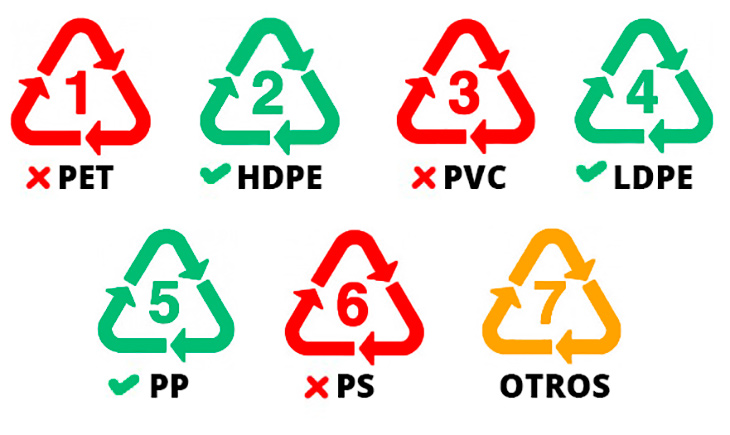In order to deal with a problem, we must first know it in order to deal with it. Plastics has become an environmental and health problem, being the cancer of our planet. And, while it is true that to solve it requires more than the commitment of the consumer (since there are production decisions that are political), knowing the different types of plastic and how they affect is the first step to be able to make responsible use of it on our part.
In this article we will talk about the different types of plastic according to their coding for recycling. Because even if we start from the basis that all plastics are toxic, there is a difference in reaction between one and the other at certain temperatures. For this reason, some are a problem for our health and others we can use them at a normal temperature without danger.
TYPES OF PLASTICS
The plastic has a coding that goes from the number 1 to 7 and that we find in the symbol of a recycling triangle. There are urban legends about this number, such as how many times they have recycled the packaging; no. This number tells us its coding, which serves to identify plastic waste. Both the number and the acronym refer to its chemical composition.

1. Polyethylene terephthalate (PET)
- Applications:
We find them in mineral water bottles, oils, bags, preserves, cosmetics, detergents, pharmaceutical products, household products, packaging, clothing, decorative fabrics and soft drinks, among others.
- Toxicity:
Indicated for single use. PET is easy to generate and store bacteria in the container itself. Avoid using it at temperatures over 50 degrees for food and beverages. It releases acetaldehyde which, among other things, can damage the heart causing cirrhosis. May contain formaldehyde, in small amounts, in plastic bottles; a bactericide and preservative that is a carcinogenic substance.
- Recycling and degradation:
PET is 100% recyclable, so it is a material that is often used a second time in clothing. Although it is very easy to recycle, the fact of giving it a second life can be harmful to our health because this plastic may contain traces of additives from previous uses. This material can take 150 years to decompose.
2. High density polyethylene (HDPE)
- Applications:
Household items, bricks, jars, toys, soaps, containers for food use, pipes, waterproof fabric, among others.
- Toxicity:
This is a safe plastic as it has no toxic components. It is recommended to store food up to 60 degrees since, from this temperature, plastic particles can be detached.
- Recycling and degradation:
It is easily recyclable but it is very resistant in terms of its biodegradability. They take more than 150 years to decompose, so if we consume them it should be for long-lasting and responsible use.
3. Polyvinylchloride (PVC)
- Applications:
Blood bags in hospitals, cables, footwear, containers, pipes, windows, toys, construction, etc.
- Toxicity: PVC can release bisphenol, phthalates and dioxins which are chemical agents that are harmful to our health and the environment. The IARC, International Agency for Research on Cancer, indicates that the vinyl chloride used in PVC is linked to various types of cancer.
- Recycling and degradation:
Difficult to recycle, that is why it is recycled mechanically, chemically, energetically and by solvents. It is very resistant and can take more than 1000 years to decompose.
4. Low density polyethylene (LDPE)
- Applications:
Shopping and garbage bags, bottles, diapers, cosmetic and hygiene containers, cling film, toys and disposable utensils among others.
- Toxicity:
LDPE does not contain toxins, therefore it is ideal for food use.
- Recycling and degradation:
Even though it is recyclable, this process is expensive and difficult but, as it is not toxic, it is a material that we can use for a long time. It can take 150 years to decompose.
5. Polypropylene (PP)
- Applications:
Bottles, automotive components, laboratory equipment, food packaging, appliances, textiles and transparent films.
- Toxicity:
It does not contain toxic in its composition, therefore, it is a safe material for food use.
- Recycling and degradation:
It can take 150 to 1000 years to decompose but, as it is a non-toxic and reusable material, it can be used for a long time. In addition, polypropylene can be recycled without problems.
6. Polystyrene (PS)
- Applications:
CD covers, electronic products and household appliances, construction materials, packaging, objects or disposable containers for food use such as glasses, cutlery and plates, yogurt containers or take away food.
- Toxicity:
Polystyrene reacts releasing styrenes at more than 80 degrees of temperature. It is considered a possible carcinogen by the International Agency for Research on Cancer and the Environmental Protection Agency.
- Recycling and degradation:
PS takes an average of 1000 years to degrade and although it can be recycled, it is not carried out because of how expensive it is.
7. Other plastics
This group is very large, since it includes all plastics that are not classified from 1 to 6, therefore, we can find totally inadvisable plastics but also those that do not contain toxic in their composition.
The best known are Tritan and SAN, which are safe plastics. The PC is better to dispense with its use, since it is manufactured with bisphenol and both PLA and ABS are safe plastics but are not recommended for making 3D prints. We can find them in reusable bottles, juice extractors and kitchen utensils, lunch boxes, automobile parts, appliances, medical items, household items, microscopes, glasses and a long etcetera.